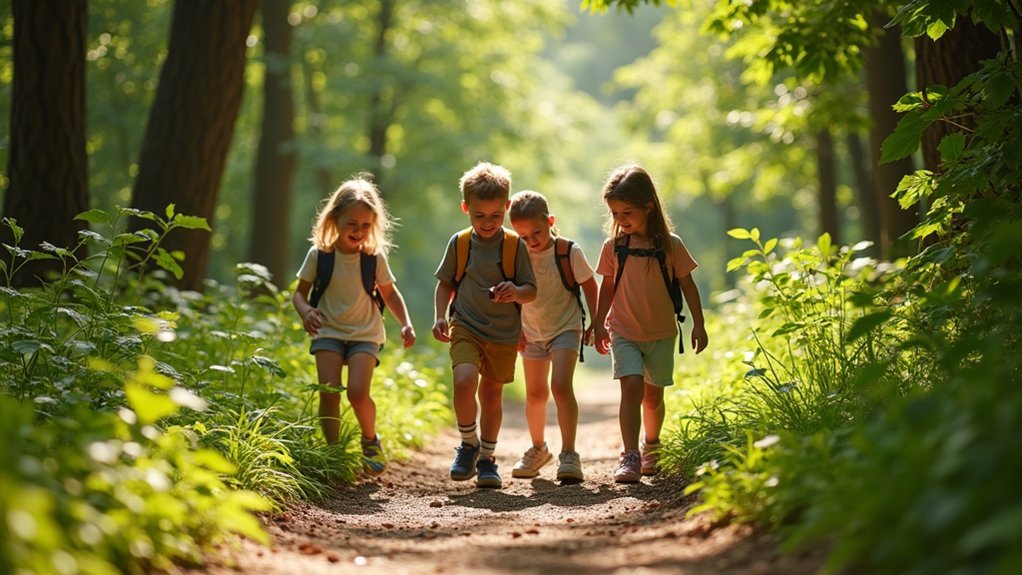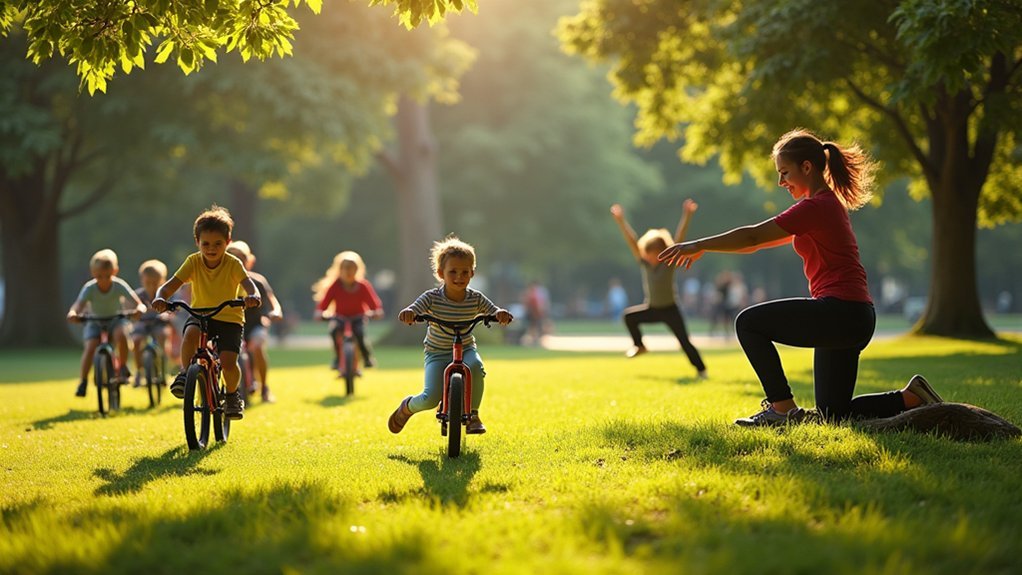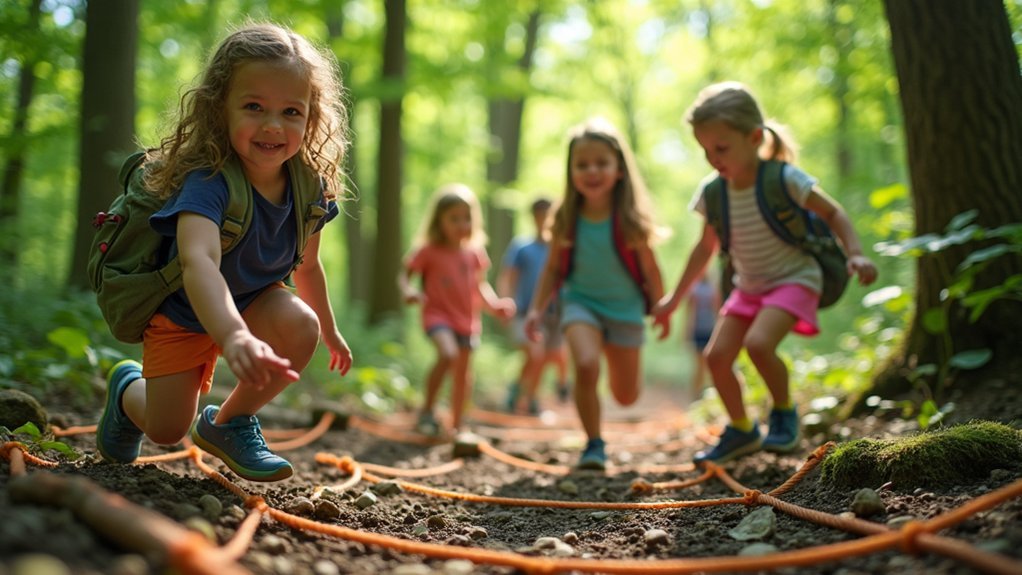Outdoor activities boost focus in people with ADHD through nature’s restorative effects on attention. Just 20 minutes in green spaces reduces mental fatigue and improves cognitive function while lowering cortisol levels. Activities like hiking, scavenger hunts, and obstacle courses channel hyperactivity productively while regulating vital brain chemicals. Sensory-rich explorations engage multiple senses, creating environments where focus comes naturally. Structured nature challenges with clear goals develop essential skills that transfer to classroom settings.
The Science Behind Nature’s Calming Effect on ADHD Symptoms

While many parents seek medication and therapy for managing ADHD symptoms, nature offers a powerful complementary approach that’s backed by science.
Research shows that natural environments actually replenish depleted attention resources—a vital benefit for children experiencing ADHD-related fatigue.
Time in nature restores what ADHD depletes—a natural remedy for mental fatigue in children.
When your child spends just 20 minutes in green spaces, what scientists call the Green Space Effect kicks in, greatly enhancing their attention span and cognitive function.
Nature exposure measurably reduces cortisol levels, helping your child regulate emotions and reduce anxiety.
You’ll likely notice improved focus and decreased impulsivity after outdoor time.
This isn’t coincidental—natural settings provide the perfect environment for attention restoration and emotional reset, making them invaluable tools in your ADHD management toolkit.
Sensory-Rich Exploration Games That Enhance Attention
Unlike traditional play settings, sensory-rich exploration games in nature offer children with ADHD an ideal environment to develop their attention skills. These activities engage multiple senses simultaneously, creating natural support for children with attention deficit disorder.
Try organizing scavenger hunts where your child can search for specific plants or natural objects, helping them improve focus while processing tactile feedback. Building structures with sticks or creating art with leaves and stones encourages sustained concentration on a single task.
Listen for nature sounds during these activities—bird calls and rustling leaves provide a calming backdrop that reduces impulsivity.
When children identify plant species or observe wildlife behavior, they’re not just playing—they’re developing essential executive functioning skills in an environment that naturally accommodates their sensory needs.
Outdoor Movement Activities That Channel Hyperactivity

Hiking through nature trails can strengthen your child’s attention span while offering structured exploration that regulates brain chemicals essential for focus.
Set up backyard obstacle courses where your child can jump, crawl, and climb to release excess energy in a purposeful way that improves coordination.
These movement-based activities transform hyperactivity into productive physical engagement, allowing for better emotional regulation and concentration when returning to classroom settings.
Hiking Builds Attention Span
Among the most effective outdoor activities for children with ADHD, nature trails provide an immersive experience that naturally enhances focus and attention.
When you take your child hiking in green settings, you’re activating the Green Space Effect—just 20 minutes on the trail can greatly improve their attention span and reduce impulsive behaviors.
Here’s how hiking specifically helps children with ADHD:
- Naturally regulates dopamine and norepinephrine levels through physical activity
- Reduces external distractions found in indoor environments
- Provides a healthy outlet for excess energy, preventing emotional meltdowns
- Restores executive functioning through exposure to nature
The structured movement of trail hiking offers a perfect balance—enough stimulation to keep your child engaged while the natural environment creates a calming effect that builds sustained attention.
Obstacle Courses Release Energy
Three powerful benefits occur when children with ADHD tackle outdoor obstacle courses. First, these structured activities provide an ideal outlet for hyperactivity while simultaneously boosting dopamine levels—the neurotransmitter that regulates attention. Second, overcoming physical challenges actually improves cognitive function and reduces impulsivity when children return to less active tasks.
| Obstacle Course Benefits | Impact on ADHD Symptoms |
|---|---|
| Physical Movement | Reduces hyperactivity |
| Social Interaction | Decreases isolation feelings |
| Skill Mastery | Builds confidence & self-esteem |
You’ll notice improved focus after your child completes an obstacle course, as their brain has processed the physical stimulation it craves. Additionally, the teamwork often required in these activities helps develop essential social skills that many children with ADHD struggle to build in traditional settings.
Green Exercise: Combining Physical Activity With Natural Settings
The powerful combination of movement and nature creates an ideal environment for children with ADHD to thrive. Green exercise helps regulate essential neurotransmitters like dopamine and norepinephrine, directly addressing core ADHD symptoms while improving mood and cognitive function.
Movement and nature together create a powerful remedy for ADHD, balancing brain chemistry while enhancing mood and mental clarity.
When you encourage your child to engage in outdoor activities, you’re offering them a natural setting that promotes:
- Improved attention spans – just 20 minutes in a park can greatly enhance focus
- Reduced impulsivity through healthy energy release
- Better emotional regulation as they explore and navigate natural environments
- Enhanced cognitive performance from the calming backdrop of nature
Natural settings provide the perfect backdrop for physical exploration while simultaneously creating a therapeutic environment that helps children manage their ADHD symptoms more effectively.
Creating Structured Nature Challenges for Skill Building

You’ll find that gamified outdoor challenges transform everyday nature exploration into skill-building opportunities for children with ADHD.
Incorporating elements like timed treasure hunts or obstacle courses using natural elements creates routines with clear purposes and goals.
These structured activities not only capture attention but also develop critical executive function skills while children enjoy the excitement of outdoor play.
Gamified Outdoor Challenges
Although conventional playground activities have their place, gamified outdoor challenges offer a structured yet flexible approach that’s particularly beneficial for children with ADHD. These activities harness nature’s restorative properties while incorporating game elements that help children concentrate better.
When designing gamified outdoor challenges for your child, consider these powerful approaches:
- Create scavenger hunts with specific targets to find, fostering sustained attention in natural settings.
- Establish team competitions that balance social interaction with structured goals.
- Set clear achievement milestones with immediate rewards to maintain engagement.
- Incorporate physical activity into challenges to help regulate dopamine levels.
You’ll likely notice improvements in focus, reduced impulsivity, and enhanced social skills as your child engages with these purposeful outdoor activities.
Routines With Purpose
Establishing routines through structured outdoor challenges takes the gamification concept further by helping children with ADHD build specific skills they can apply throughout their lives. When you create structured nature challenges for kids with ADHD, you’re not just entertaining them—you’re developing their time management abilities through timed activities that maintain engagement.
Consistent time in nature provides the predictability these children need while teaching valuable social skills through team-based challenges.
Try alternating between high-energy obstacle courses and calming nature walks to help your child regulate emotions and energy levels. This balanced approach creates purposeful routines that improve focus while building confidence.
The goal-oriented structure of these outdoor activities satisfies their need for stimulation while simultaneously developing essential life skills they’ll use in school and beyond.
Adaptive Outdoor Equipment That Supports Focus and Engagement
When children with ADHD explore the outdoors, specialized equipment can dramatically improve their experience by supporting their unique sensory and movement needs.
Adaptive outdoor equipment creates environments where focus comes more naturally and engagement lasts longer.
Consider integrating these ADHD-friendly options:
- Sensory swings and fidget tools – Provide tactile stimulation that helps regulate attention while enjoying nature.
- Balance boards and climbing structures – Encourage physical movement that naturally regulates key neurotransmitters.
- Interactive nature trails – Use clear signage and activity stations to maintain engagement during exploration.
- Portable seating options – Offer hammocks or bean bags as comfortable reset spaces when energy management is needed.
You can also incorporate GPS devices or nature apps to transform simple outdoor time into interactive learning adventures.
Seasonal Outdoor Activities That Regulate Sensory Processing
The natural world offers a powerful regulatory system for children with ADHD through its ever-changing seasonal landscapes. Each season provides unique sensory experiences that can help your child better process information and manage impulses.
| Season | Activity | Sensory Benefit |
|---|---|---|
| Spring | Gardening | Tactile exploration with soil improves attention span |
| Summer | Nature Walks | “Green time” reduces anxiety and enhances focus |
| Fall | Leaf collecting | Proprioceptive input aids emotional regulation |
| Winter | Snow fort building | Spatial awareness development improves processing |
Increasing your child’s Time Outside through seasonal activities like soccer in fall or hiking in summer stimulates multiple senses simultaneously. This natural sensory diet helps regulate their nervous system, making it easier to focus when they return to structured environments.
Frequently Asked Questions
How Does Being Outside Help ADHD?
Being outside helps your ADHD by improving your attention span, reducing impulsivity, lowering stress hormones, and regulating brain chemicals. Natural environments provide a calming effect that enhances your focus and emotional regulation.
What Is the 30% Rule in ADHD?
The 30% rule suggests you’ll experience improved ADHD symptoms when you spend about 30% of your time in stimulating natural environments. It’s a guideline that helps you balance structured activities with restorative outdoor experiences.
What Helps ADHD People Focus?
You’ll focus better with outdoor activities, structured routines, medication, and reduced distractions. Nature exposure for 20 minutes daily greatly improves your attention. Regular exercise, adequate sleep, and mindfulness practices also enhance your cognitive function with ADHD.
What Outdoor Activities Are Good for People With ADHD?
You’ll find great focus benefits from running, team sports, nature walks, and gardening. These activities regulate your brain chemicals, improve attention span, and reduce impulsivity while you’re moving and exploring outdoors.
In Summary
You’ve discovered powerful ways to harness nature’s therapeutic benefits for ADHD management. By incorporating these outdoor activities into your routine, you’ll help regulate energy levels while building focus naturally. Remember, it’s not just about getting outside—it’s about engaging purposefully with environments that support attention and reduce symptoms. Start small, notice what works best, and you’ll create sustainable practices that improve focus year-round.





Leave a Reply